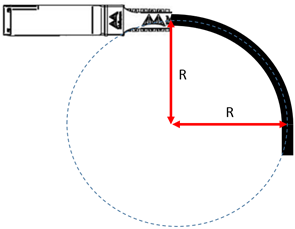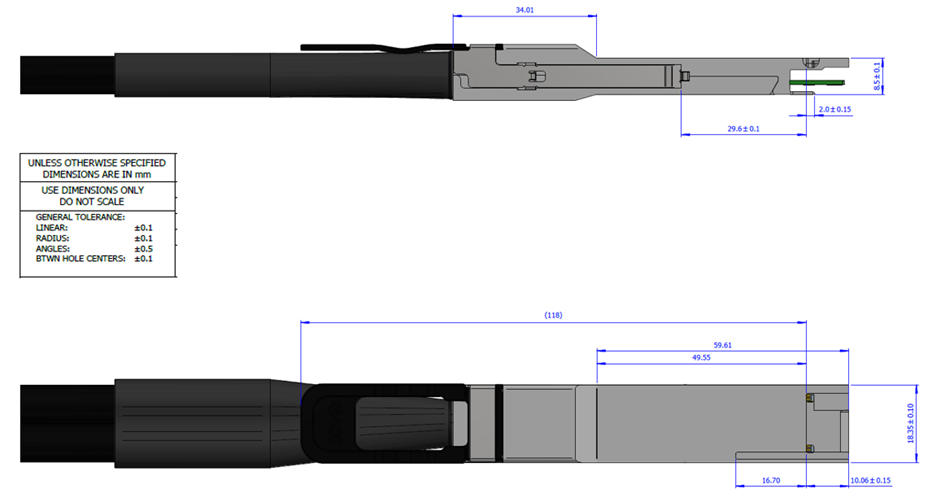Specifications
Absolute maximum ratings are those beyond which damage to the device may occur.
Prolonged operation between the operational specifications and absolute maximum ratings is not intended and may cause permanent device degradation.
|
Parameter |
Min |
Max |
Units |
|
Supply voltage |
-0.3 |
3.6 |
V |
|
Data input voltage |
-0.3 |
3.6 |
V |
|
Control input voltage |
-0.3 |
3.6 |
V |
|
Parameter |
Min |
Max |
Units |
|
Storage temperature |
-40 |
85 |
°C |
This section shows the range of values for normal operation.
|
Parameter |
Min |
Typ |
Max |
Units |
|
Supply voltage (Vcc) |
3.135 |
3.3 |
3.465 |
V |
|
Power consumption |
--- |
--- |
0.1 |
W |
|
Operating case temperature |
0 |
70 |
°C |
|
|
Operating relative humidity |
5 |
85 |
% |
|
Parameter (per lane) |
Min |
Typ |
Max |
Units |
|
Characteristic Impedance |
90 |
100 |
110 |
Ω |
|
Time propagation delay1 |
--- |
--- |
4.5 |
ns/m |
1 Informative
Note: Minimum insertion loss for up to 1m cable length is 6dB @ 12.89GHz.
QSFP-DD Memory Map I2C Address A0h
|
Page 00h/ |
Register Name |
Description |
|
0 |
Identifier |
18h: QSFP-DD |
|
1 |
Version ID |
28h: Version of QSFP-DD Serial Module Specification. |
|
86 |
Electrical Interface Code |
1Dh: 400G CR8 PAM4 channel |
|
87 |
Interface Advertising Code |
01h: Copper cable |
|
88 |
Host/Media Lane Count |
88h: 8 host electrical lanes and 8 module media lanes |
|
89 |
Lane Assignment |
01h: Permissible first lane for application: lane 1 |
|
128 |
Identifier |
18h: QSFP-DD |
|
129-144 |
Vendor name |
Mellanox: ASCII |
|
145-147 |
Vendor OUI |
00-02-C9: Mellanox OUI. |
|
148-163 |
Part number |
MCP1660-W0xxEyy: Part number per backshell label (ASCII) |
|
164-165 |
Product revision |
ZZ: Revision per backshell label (ASCII) |
|
166-181 |
Serial number |
Serial number on backshell label (ASCII). |
|
182-187 |
Date code |
YYMMDD: Year YY, month MM, day DD. |
|
202 |
Length |
b7 – b6: Multiplier for value in bits 5-0: 00 = multiplier of 0.1 01 = multiplier of 1 10 = multiplier of 10 11 = multiplier of 100 b5 – b0: Link length base value in meters. To calculate actual link length use multiplier in bits 7-6. Examples: 1m: 41h 2.5m: 19h |
|
204 |
Attenuation 5GHz |
Typical attenuation measured during production test, in 1dB. [dB] |
|
205 |
Attenuation 7GHz |
|
|
206 |
Attenuation 12.9GHz |
|
|
207 |
Attenuation 25.8GHz |
Cable Mechanical Specifications
|
OPN |
AWG |
Single Cable Diameter |
Minimum Bend Radius |
Length (M) |
Cable Color |
|
MCP1660-W00AE30 |
30 |
7.1 ±0.35 |
Single bend: 35.5 Assembly/repeated bend: 71 |
0.5 ±0.025 |
Black |
|
MCP1660-W001E30 |
1 ±0.025 |
||||
|
MCP1660-W01AE30 |
1.5 ±0.025 |
||||
|
MCP1660-W002E26 |
26 |
9.4 ±0.4 |
Single bend: 47 Assembly/repeated bend: 94 |
2 ±0.050 |
|
|
MCP1660-W02AE26 |
2.5 ±0.050 |
||||
|
MCP1660-W003E26 |
3 ±0.050 |
The minimum assembly bending radius (close to the connector) is 10x the cable’s outer diameter. The repeated bend (far from the connector) is also 10x the cable’s outer diameter. The single bend (far from the connector) is 5x the cable’s outer diameter.
Assembly Bending Radius

Mechanical Dimensions


Cable Length Definition

*Ordered OPN length.
The following label is applied on the cable’s back-shell:

Images are for illustration purposes only. Product labels, colors, and lengths may vary.
Back-Shell Label Legend
|
Symbol |
Meaning |
Notes |
|
SN – Serial Number |
||
|
MT |
Manufacturer name |
2 characters, e.g. MT |
|
YY |
Year of manufacturing |
2 digits |
|
WW |
Week of manufacturing |
2 digits |
|
XX |
Manufacturer site |
2 characters |
|
SSSSS |
Serial number |
5 digits for serial number, starting from 00001. Reset at start of week to 00001. |
|
Miscellaneous |
||
|
ZZ |
HW and SW revision |
2 alpha-numeric characters |
|
YYYY |
Year of manufacturing |
4 digits |
|
MM |
Month of manufacturing |
2 digits |
|
DD |
Day of manufacturing |
2 digits |
|
COO |
Country of origin |
E.g. China or Malaysia |
|
Quick response code |
Serial number (MTYYWWXXSSSSS) |
|
Copper Cable Jacket Label (Middle of Cable)
The following label is applied on the cable’s jacket:

Regulatory Compliance and Classification
Safety: CB, UL, CE
EMC: CE, FCC, ICES, RCM, VCCI
Ask your field engineer for a zip file of the certifications for this product.
FCC Class A Notice
Each of the devices complies with CFR47 FCC Class A Part 15 of the FCC Rules. Operation is subject to the following two conditions:
This device may not cause harmful interference.
This device must accept any interference received, including interference that may cause undesired
Note: This equipment has been tested and found to comply with the limits for a Class A digital device, pursuant to Part 15 of the FCC Rules. These limits are designed to provide reasonable protection against harmful interference in a residential installation. This equipment generates, uses and can radiate radio frequency energy and, if not installed and used in accordance with the instructions, may cause harmful interference to radio communications. However, there is no guarantee that interference will not occur during installation. If this equipment does cause harmful interference to radio or television reception, which can be determined by turning the equipment off and on, the user is encouraged to try to correct the interference by one or more of the following measures:
Reorient or relocate the receiving antenna.
Increase the separation between the equipment and receiver.
Connect the equipment into an outlet on a circuit different from that to which the receiver is connected.
Consult the dealer or an experienced radio/television technician for help.
Modifications: Any modifications made to this device that are not approved by NVIDIA may void the authority granted to the user by the FCC to operate this equipment.

Handling Precautions and Electrostatic Discharge (ESD)
The cable is compatible with ESD levels in typical data center operating environments and certified in accordance with the standards listed in the Regulatory Compliance Section. The product is shipped with protective caps on its connectors to protect it until the time of installation. In normal handling and operation of high-speed cables and optical transceivers, ESD is of concern during insertion into the QSFP cage of the server/switch. Hence, standard ESD handling precautions must be observed. These include use of grounded wrist/shoe straps and ESD floor wherever a cable/transceiver is extracted/inserted. Electrostatic discharges to the exterior of the host equipment chassis after installation are subject to system level ESD requirements.
Cable Management Guidelines
It is important to follow the instructions and information detailed NVIDIA Cable Management Guidelines and FAQ Application Note to insure proper and optimal installation of this cable and avoid physical damage.